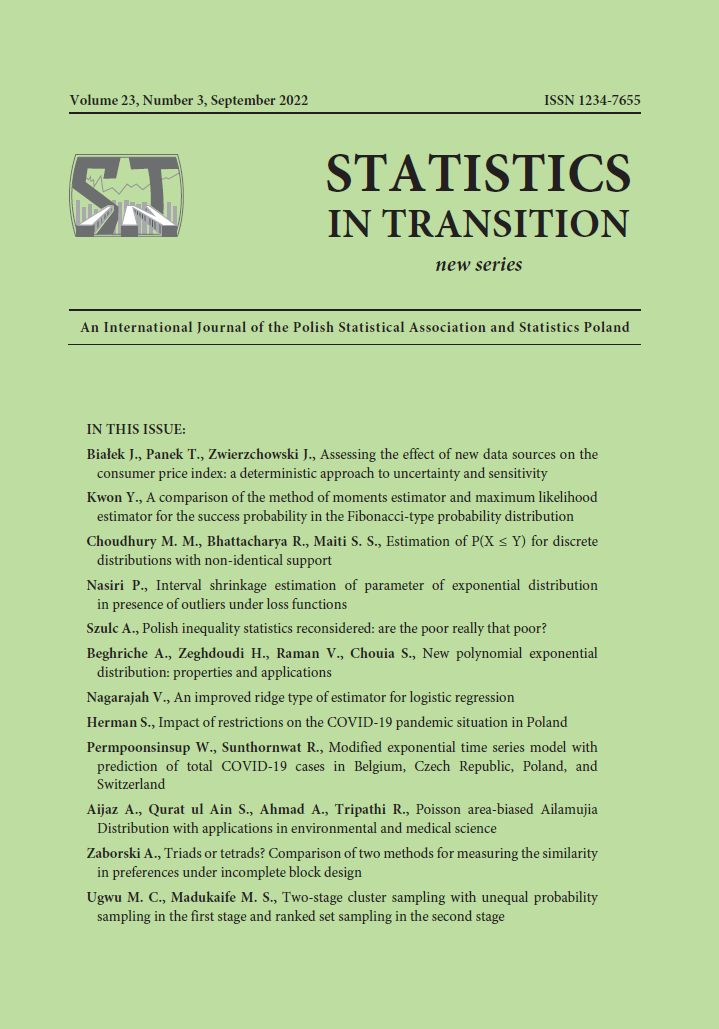ARTICLE
ABSTRACT
In this paper, a new Poisson area-biased Ailamujia distribution has been formulated to analyse count data. It was created by combining two distributions: the Poisson and areabiased Ailamujia distributions, using the compounding technique. Several distributional properties of the formulated distribution were studied. Its ageing characteristics were determined and expressed explicitly. A variety of diagrams were used to demonstrate the characteristics of the probability mass function (pmf) and the cumulative distribution function (cdf). The parameter of the developed model was estimated by employing the maximum likelihood estimation approach. Finally, two data sets were used to demonstrate the effectiveness of the investigated distribution.
KEYWORDS
compound technique, Poisson distribution, area-biased Ailamujia distribution, reliability analysis, order statistics, maximum likelihood estimator.
REFERENCES
Fisher, R., (1934). The effect of methods of ascertainment, Annals Eugenics, 6, pp. 13-25.
Rao, C. R., (1965). On Discrete Distributions Arising Out of Methods of Ascertainment. Sankhya; the Ind. J. Statist, series A, 27(2/4), pp. 311-324.
Gerstenkorn, T., (1993). A compound of the generalized gamma distribution with the exponential one. Recherches surles deformations,16(1), pp. 5-10.
Gerstenkorn, T., (1996). A compound of the Polya distribution with beta distribution. Random oper. And Stoch. Equ., 4(2), pp. 103-110.
Giovani, C. R., Francisco, L., and Pedro, L. R., (2016). Poisson-Exponential distribution different methods of estimation. Journal of applied statistics, 15(45), pp. 128-144.
Gupta, R. C., Ong, S. H., (2004). A new generalization of negative binomial distribution. Journal of computational statistics and data analysis, 45, pp. 287-300.
Greenwood, M., Yule, G. U., (1920). An inquiry into the nature of frequency distribution representative of multiple happenings with particular reference to the occurrence of multiple attacks of disease or of repeated accidents, J. Roy. Stat. Soc., 83, pp. 225-279.
Judcy, C., (1942). Data on the macroscopic fresh-water fauna in dredge samples from the bottom of Weber Lake.
Mahmoudi, E., Zakerzadeh H., (2010). Generalized Poisson-Lindley distribution. Communications in statistics - theory and methods, 39(10), pp. 1785-1798.
Puig, P., Valero J., (2006). Count Data Distributions, Some Characterizations With Applications. Journal of the American Statistical Association, 101, pp. 332-340.
Shanker, R., (2017). The discrete Poisson-Akash distribution. International journal of probability and statistics, 6(1), pp. 1-10.
Sankaran, M., (2010). The discrete Poisson-Lindley distribution. Biometrics, 26, pp. 145-149.
Subhradev, S., (2018). Quasi-Xgamma distribution. Istatistik: journal of the Turkish statistical association, 11(3), pp. 65-76.
Shanker, R., Shukla, K.K., (2019). A generalization of Poisson-Sujatha distribution and its application to ecology. International journal of biomathematics, 12(2), pp. 66-83.
Thomas, M., (1949). A generalization of Poisson’s binomial limit for use in ecology. Biometrika, 36(2), pp. 18-25.
Wanbo, L., Shi, D., (2012). A new compounding life distribution: the Weibull-Poisson distribution. Journal of applied statistics, 39(1), pp. 21-38.
Zamani, H., Ismail, N., (2010). Negative binomial-Lindley distribution and its application. Journal of mathematics and statistics, 1, pp. 4-9.
